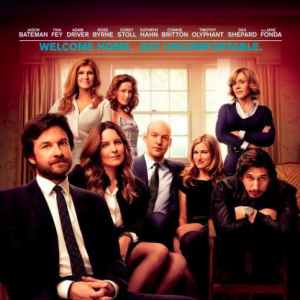An adult, character-driven comedy-drama without special effects, action scenes or raw adolescent humor?
From Warner Bros?
The studio that practically invented the tent pole picture?
How did this happen?
We can only guess.
All I can say is that occasionally the system breaks down, and a terrific film with something on its mind manages to slip through.
Heads will certainly roll over a screw-up of this magnitude.
The film in question is This Is Where I Leave You.
Even the title breaks the studio rules, inviting cheap shots from critics like “This is where I leave this film.”
I’d advise you to stay with it…to the very end.
What’s it about?
Well, there’s another problem. The story can’t be reduced to a single sentence or phrase—a “logline” as the studios like to call them. It has no “high concept” for the marketing team to build a campaign around.
It focuses on Judd Altman (Jason Bateman), a play-it-safe sort of guy whose comfortable world falls apart when he comes home early to surprise his wife on her birthday and discovers her in bed with his boss.
That’s shattering blow number one.
Number two comes not long after when his father dies.
Number three is a summons home from his widowed mother, who insists that he and his siblings hold a week-long shiva to mourn the departed.
Jason, with neither wife nor job, dreads the idea of being locked up in the same house with the other members of his completely dysfunctional family, all of them as messed up as he is, none of them capable of getting along with the others.
But Mother’s will be done.
She is played by Jane Fonda, who gives by far her best performance since her return to acting. An oversexed celebrity analyst, she is the author of a best-selling guide to raising children, a guide that focuses on her own family and reveals such humiliating secrets as the adolescent promiscuity of her daughter Wendy (Tina Fey) and the fact that her youngest son (Adam Driver) used to treat his penis like “a Tootsie-Roll.”
And so it goes.
One colorful, outrageous, eccentric character after another.
I can almost hear you saying, “Great. Another dysfunctional family reunion story. How many times have I seen that?”
Trust me.
You’ve never seen this story before.
It will constantly surprise you.
You will expect, of course, to have the movie end with multiple reconciliations and the resolution of its many conflicts, with the reassurance that they all lived happily ever after.
But in This Is Where I Leave You, they don’t.
They’ve grown, they have hope, they’ve called an uneasy truce with each other, but for every problem solved, a new one has arisen, and they leave their hometown with almost as many challenges as they brought to it when they arrived.
Outrageous, hilarious, and often very moving, This Is Where I Leave You is not a perfect film, but it is a thoughtful meditation on love—how hard it is to find, how hard it is to sustain, how impossible it is to understand.
My hat is off to director Shawn Levy, who’s come a long way from the Night at the Museum series, to writer Jonathan Tropper who so brilliantly adapted his own novel to the screen, and to the amazing cast.
And my condolences to the Warner executive who shepherded this film through the system to the screen. He or she is probably already looking for another job. There is simply no excuse for good taste in today’s corporate studio world.
An Afterword
I had the privilege of working with Jason Bateman years ago on a cable film that was supposed to be called Blood Brothers but somehow ended up A Taste for Killing. It starred Jason, Jim Cameron favorite Michael Biehn, and E.T.’s Henry Thomas. Michael had the flashiest role, but Jason was the stand-out…and a total pro–warm, friendly to everyone on the set, always prepared, ready to jump from reading Grisham’s The Firm between set-ups to complete immersion in his character the instant he was called for a shot. He was terrific then and he’s better now. Those of you who’d like the full story of the making of the film might want to check out the chapter I devote to it in Confessions of a Hollywood Nobody. Both the book and the film are available on Amazon.










